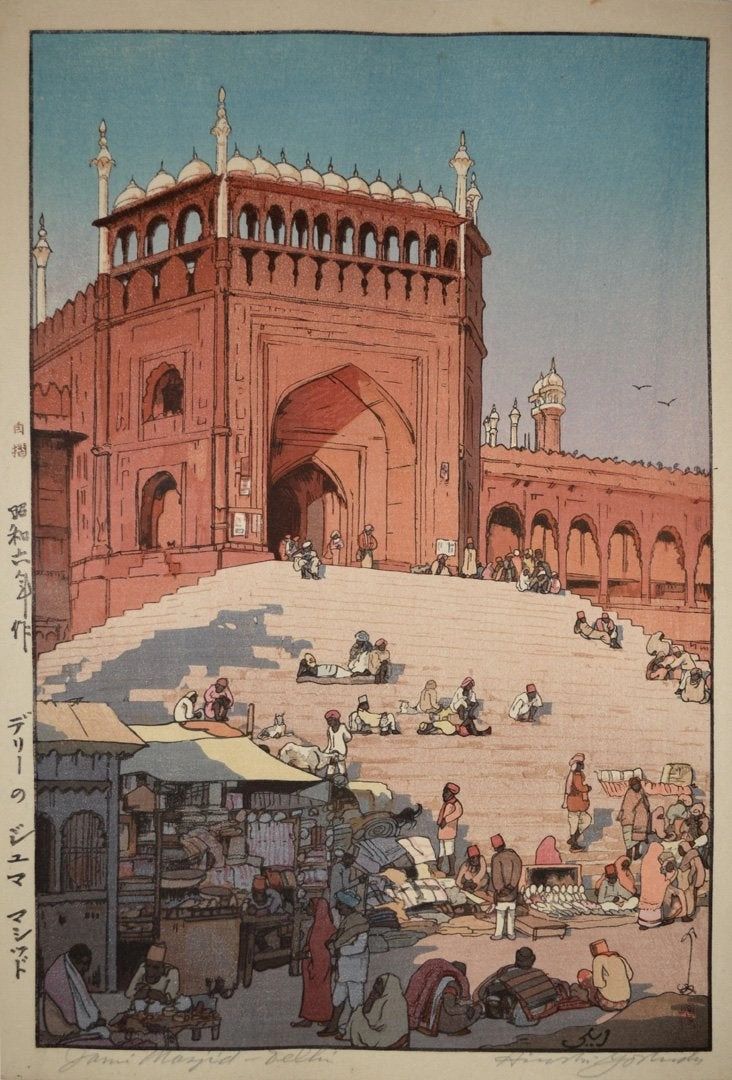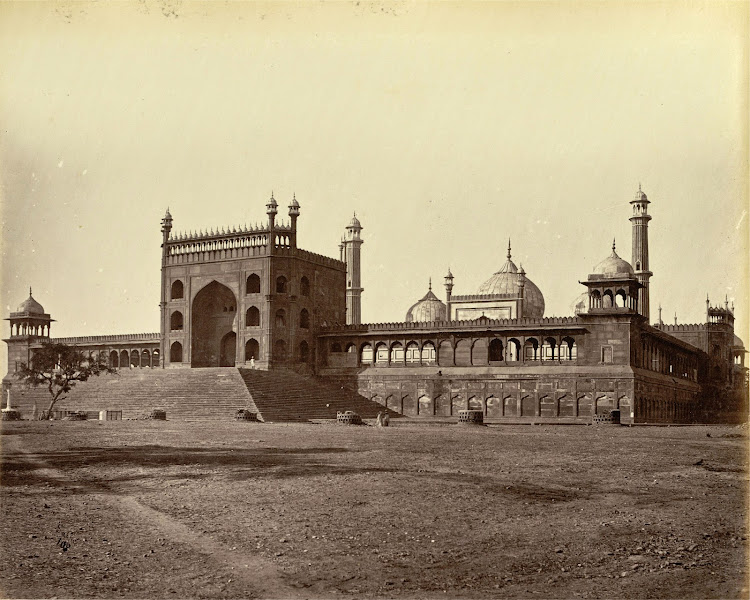The city of Shahjahanabad was constructed in nearly a decade. Several landmarks and markets in the city were established during this period. Among these landmarks was a mosque, which was built under the patronage of Shah Jahan to accommodate the ever-growing residents and worshippers. There were several mosques already present in the city, some of them commissioned by the emperor’s wives. However, the emperor Shah Jahan, being famously fond of building monuments, commissioned the building of the largest mosque, not only in his capital but in the entire subcontinent at that time. This mosque was the Jama Masjid of Delhi.

History:
Mughal emperor Shah Jahan decided to shift his capital from the city of Agra, and the construction of the new capital was undertaken in the 1640s. This new capital city, called Shahjahanabad, was constructed around the Lal Qila (the Red Fort of Delhi), which was the residence of the emperor. Shahjahanabad, the emperor felt, required a new congregational mosque capable of accommodating more people than the existing mosques of the city due to the increasing population.

Pahari Bhojala is a hill that is about a kilometer from the Red Fort. Interestingly, this hillock was a hideout of an infamous dacoit named Bhojla. This was long before Shah Jahan shifted his capital, but the name of the hill stuck around. Anyhow, this was decided as the location for the new congregational mosque commissioned by the emperor. The mosque was to cover the entirety of this hill. Owing to its elevation, the imperial mosque was named Masjid-e-Jahan Numa (a mosque that provided a view of the world). It is also called the Jama Masjid or the Jami Masjid, which is Arabic for congregational mosque. Two main routes extended from the Red Fort, one towards the Chadini Chowk to the west and the other towards the Faiz Bazaar to the south. Between these roads lay the Jamma Masjid.
The foundational stone of the Jama Masjid was laid on the 10th of Shawwal in the Islamic year 1060, or 6th October 1650 a.d., by Shah Jahan. The imperial mosque was built between 1650 and 1656. The Mughal prime minister Sa’dullah Khan and Khansama Fazil Khan were designated the responsibility of overseeing the construction. The mosque reflects a Byzantine Arabic style of architecture.

The mosque was inaugurated in 1656 A.D. on the occasion of Eid-ul-Fitr. An interesting anecdote is related to the inauguration of the mosque. The emperor expressed his desire to inaugurate the mosque on the festival of Eid, a day before the festival. The mosque still had debris, spare tools, and construction material that hadn’t been cleared yet scattered around. It would have been difficult to clear all the debris in one day alone. Thus, it was decided by the officials in charge to allow the people from the city to take home all the leftover materials and scraps free of cost. This resulted in a swift clearing up and decoration of the mosque, which would have taken a much longer time otherwise. The next day, on the festival of Eid, the emperor arrived in a grand procession. A large crowd of worshippers joined him in the prayer (the Masjid has the capacity to accommodate nearly 25,000 people). Later, the officials and other people who were involved in the building of the mosque were rewarded by the emperor.
A few relics of Prophet Mohammed (p.b.u.h) are also preserved in the mosque. Sultan Bayuzid came upon these relics when he conquered Turkey in 1414 A.D. Soon after, he was defeated by Amir Taimur Gorgani, who took possession of these relics. The Mughals were the direct descendants of Amir Taimur, or Tamerlane, and thus these relics were passed on to Shah Jahan, who later preserved them in the Jama Masjid. The chief relics include a stone with an impression of the footprint of the Prophet Mohammad, a pair of leather sandals worn by him, a portion of the Quran written by Imam Hasan, a portion of the Quran written by Hazrat Ali, and a complete copy of the Quran written by Imam Husain.
The Revolt of 1857 and After:

Shahjahanabad was the capital city of the Mughals even during the time of the last Mughal emperor. After the revolt of 1857, the British forces took over the city, and devastation and plunder followed. Almost all of the monumental architecture of the city was ruined, so much so that the surviving structures symbolized hopes of cultural survival. A poet wrote:
Thank God, the Jama‘Masjid remained standing!
There is now hope that it was saved, the life of Delhi.
The Masjid was also a symbol of the imperial authority of the Mughal, and therefore, it became important for the British to control it. The British deliberated upon several alternatives that would become the fate of the Jamma Masjid, like turning it into a church or a college. Ultimately, it became a temporary barracks for Sikh soldiers from Punjab. The mosque was under British control for five years after the revolt, after which, on 28th November 1862, it was returned to the Muslims, albeit under strict regulations. Even the Khutba (Friday sermon) at Jama Masjid would praise the British in the earlier period, post the revolt. Nonetheless, over time, people regained control over the mosque.
Architecture:

The Jama Masjid is 261 feet in height and 90 feet in width. The mosque is built on an elevation and is around 10 meters above other structures of the city. It was constructed using red sandstone and white marble, which were common materials that were used in the Mughal period structures. The mosque is also similar to the Jama Masjid of Agra, which perhaps served as an inspiration. There are three archways to enter the mosque: in the north, the south, and the east. The structure has five stories in total, each of which has its own balcony. The first three storeys, as well as the fifth storey, are made of red sandstone, while the fourth one is made of marble. The mosque also includes four towers as well as two minarets. These minarets are 40 meters in length and have 130 steps inside them.

The square corridor, or the courtyard of the mosque, is nearly 115 meters, and the main prayer hall (which is approx. 61 x 27 meters) is located to its west. Two hundred and sixty pillars support this hall and 15 other marble domes. The courtyard is framed by corridors and galleries. The floor is made up of black and white marble, which creates a pattern that resembles the prayer mats used by Muslims. There is a hauz (reservoir) in the courtyard that provides water for people to perform Wudhu (ablution) before offering prayer. The water was provided to this reservoir through a Persian wheel, which was located a little away from the mosque. This Persian wheel is currently in a room with an inscription that explains its purpose.


Style of Architecture:
The mosque is made of red sandstone with white marble accents. The Indo-Islamic style of architecture is evident in the mosque due to its prominent features like the geometric patterns and use of arches. The arches of the mosque are ogee-style arches, which are commonly used in Islamic architecture. Other features, like the minarets, are also typically used in this type of architecture. Indian influences like chhatris (domed pavilions) are also used. There are several calligraphic inscriptions inside the mosque as well. For instance, the ten outer arches have calligraphic inscriptions in Persian written in Arabic Naskhi characters, which tell us about the history of the mosque, the name of the founder, the cost and time for making the mosque, and the description of its architecture. Along with calligraphy, the walls of the mosque also have other geometric patterns as well as floral motifs.

.jpg)
Conclusion:

Currently, the Archaeological Survey of India (ASI) is responsible for the upkeep and preservation of the Jama Masjid of Delhi, which is one of the largest mosques in Delhi. Thousands of Muslims offer their prayers at this mosque even today, especially on Friday (Jumu’ah) and Eid. People also gather here for iftar during the month of Ramadan to break their fasts. There are several other attractions in the vicinity of the mosque, so, along with worshippers, several tourists also visit the Jama Masjid in large numbers. Thus, the Jama Masjid is a valued part of Delhi’s history, drawing both locals and visitors alike.
References:
- Aziz-Ur-Rahman. History of Jama Masjid and Interpretation of Muslim Devotions. Roxy Printing Press, 1936.
- https://shahjahanabad.eheritageproject.in/pahari-imli-and-pahari-bhojla/
- https://www.omicsonline.org/open-access/jama-masjid-of-delhi-a-majestic-icon-of-islamic-architecture-125419.html#:~:text=Efforts%20have%20been%20made%20to%20preserve%20the%20historical%20and%20cultural,and%20ensuring%20its%20structural%20integrity.
- https://www.veenaworld.com/blog/jama-masjid-delhi-mughal-architecture-at-its-best
- https://ranasafvi.com/glorious-history-of-delhis-jama-masjid-the-mosque-that-promised-a-view-of-the-world-2/
- https://www.orientalarchitecture.com/sid/1833/india/delhi/jama-masjid-of-delhi
- https://www.kaarwan.com/blog/architecture/jama-masjid-a-masterpiece-of-indo-islamic-architecture?id=409
- https://www.indianpanorama.in/spiritual/muslim-pilgrimage-india/jama-masjid.php




